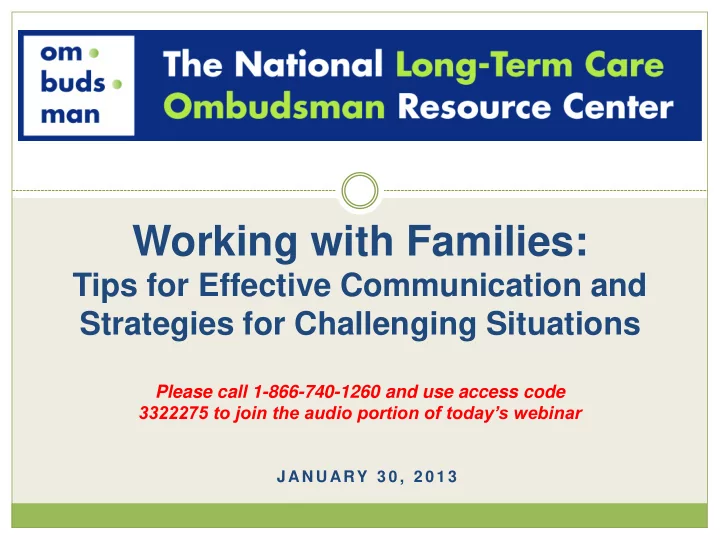

Working with Families: Tips for Effective Communication and Strategies for Challenging Situations Please call 1-866-740-1260 and use access code 3322275 to join the audio portion of today’s webinar J AN U ARY 3 0 , 2 0 1 3
Overview of Webinar Role of the LTCO when working with families Tips for effective communication Strategies for challenging situations Review scenarios Discussion questions Question and Answer Closing
LTCO Work with Family Members Who Filed Complaints with the LTCOP NHs and ALFs/B&C- 2011 NORS data 15,866 Resident 49,850 Relative/Friend 22,554 Facility Admin/Staff LTCO 25,215
LTCO Work with Family Members Other Ombudsman Activities (total state and local counts-2011 NORS data): Number of consultations to individuals (includes family members): 288,698 Number of Family Council Meetings Attended: 3,321 Number of Community Education Sessions (could include current and future family members): 12,456
Importance of Working with Families Family member may be the legal representative and/or complainant Gain information about the resident (e.g. preferences, history, routines, values) Learn about family dynamics Resident may need family support Empower family members Family members share their positive experience with the LTCOP with others
Effective Communication
Quick Tips! Use “I” Statements “Own” your statements and views and do not claim to speak for others Avoid saying “you” as people may feel they are being accused Don’t say, “When you …” instead say, “What I would like to see happen is…” Avoid emotive words that are tied to a person’s perception For example: Don’t say: “she barged into the room” Instead use a neutral, factual statement: “she came into the room suddenly”
Quick Tips! Use “open - ended” questions Helps build rapport and shows empathy You may gain more information Avoid using “why” as people may feel like they are being accused or attacked Use “how,” “tell me,” and “what” For example: Don’t say: “Why were you late this morning?” Say: “Help me understand what made you late this morning.”
Quick Tips! Use “reflective listening” Way to validate and affirm the speaker by giving them the experience of being heard and acknowledged Restate (in your own words) the content and/or feeling of what someone tells you Types: paraphrasing, reflecting feeling and summarizing For example: A family member says, “My mother has had a lot of issues regarding her meals recently. Her meals are often cold and bland. When she asks about an alternative they only offer a sandwich. We’ve addressed these concerns, but it only gets better for a week or so.”
Quick Tips! Reflective Listening Example Paraphrase: “You and your mother have addressed concerns about the food temperature, taste and lack of variety, but it is an on- going issue.” Reflect feeling: “It must be frustrating that your mother’s concerns have not been resolved and she is not enjoying her dining experience.” Summarize: “It must be frustrating that your mother is not enjoying her dining experience, especially since you have both addressed these concerns, on multiple occasions, with the staff. I would be happy to speak with your mother and see if I can provide assistance and advocacy regarding her dietary concerns.”
First Time Speaking with a Family Member Remember to: Use reflective listening Discuss the role of the LTCO Determine their motivation by asking them what outcome they are seeking Be clear about what you can and cannot do Inform them that your next step will be speaking with the resident
Communicating the Role of the LTCO Establish a clear understanding of the role of the LTCO during the first conversation “I am a resident advocate. I am here for your mother and what she needs, and hopefully we can all work together on this.” If the family member says her loved one has dementia and can’t communicate… “I understand what you are saying. I will go and see her and after visiting with her we can see where we’ll go from there.”
Establishing Credibility Be clear and direct about the LTCO role Meet with family members and residents before meetings scheduled with the facility and walk in together Sit next to the resident, if possible, or the family member during meetings with facility staff When you interact with facility staff (in the facility or community) be professional and courteous, but not overly friendly (e.g. offer handshakes, not hugs) If you know a staff member (e.g. former colleague, friend from school) disclose that information
What if the resident does not give consent… Points to address… Emphasize what you CAN do… Potential fear of retaliation Check in with the resident during future visits When residents make choices, Encourage the family member to they regain some control share her concerns with the resident Resident’s priorities may differ Share observations of the resident from their family member with the family member See if other residents have a Despite their impairments, similar complaint residents are still adults and it is important to support their rights Inform the family member of steps they can take
Communication Skills and Information for Families Barriers to Self-Advocacy Fear retaliation by facility towards their loved one or themselves Unsure how to address concerns Afraid facility will consider them a “complainer” or “difficult” and dismiss their concerns Tips Remind family members of applicable regulations (e.g. right to voice grievances without fear of reprisal) Encourage them to document all aspects of complaint process and facility’s response Share information and resources regarding the problem-solving process
Role of LTCO in Teaching Self-Advocacy Encourage family members to speak with their loved one to see if he or she shares their concern and whether the resident wants anything to be done about the matter Urge families to honor the resident’s wishes and/or preferences Explain why consulting with and being guided by their loved one is important
Resources for Family Members Family Advocacy Toolkit (Problem-Solving Process Resources) Problem-Solving Process for Families (chart) Problem-Solving Worksheet for Families Problem-Solving Worksheet for Families-EXAMPLE Documentation Tips for Family Members Strategies for Addressing Concerns in Long-Term Care Facilities
Recommend
More recommend